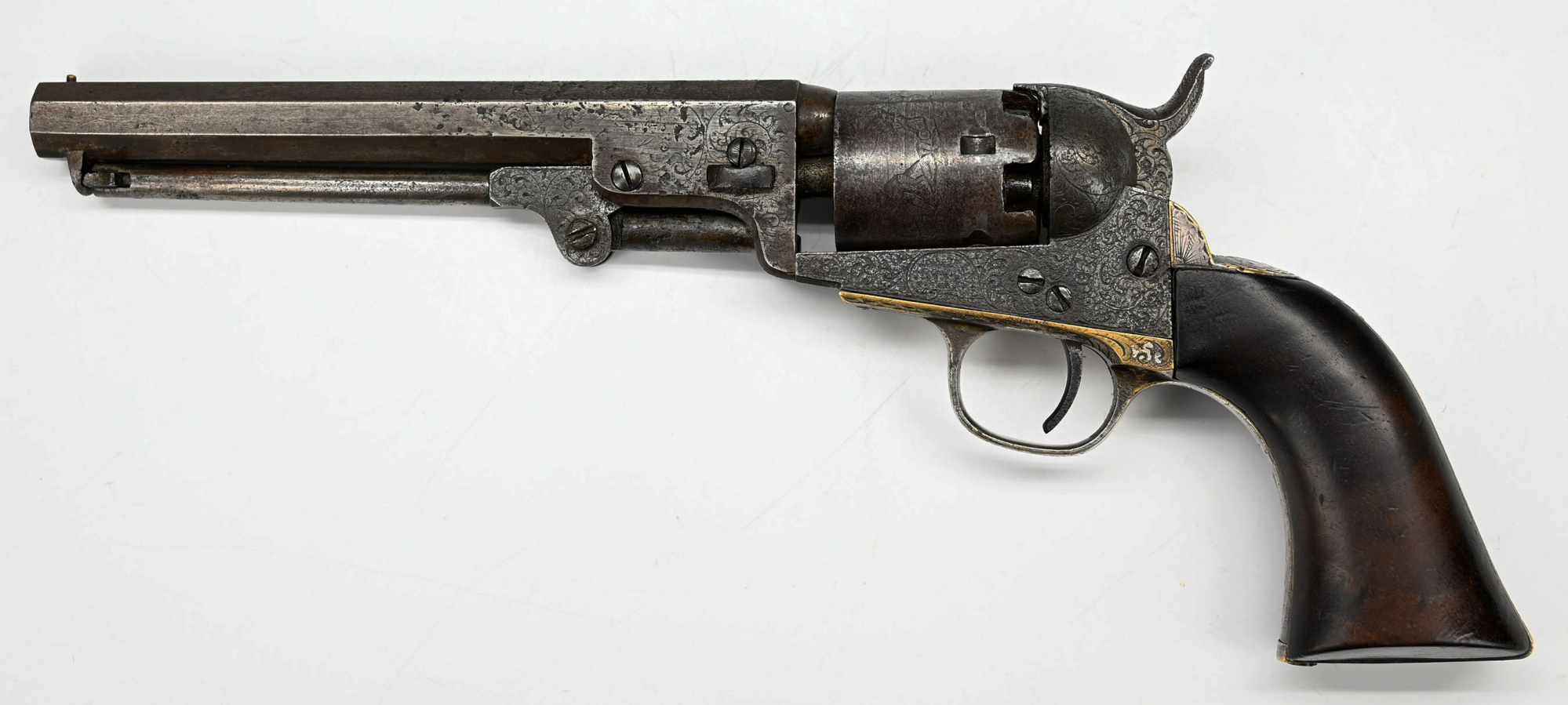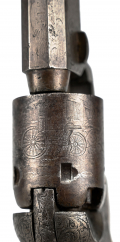site search
online catalog
FACTORY ENGRAVED GUSTAVE YOUNG STYLE COLT POCKET MODEL INSCRIBED TO CAPT. CHAUNCEY MCKEEVER: BULL RUN; 3rd CORPS CHIEF OF STAFF, PENINSULAR CAMPAIGN, SECOND BULL RUN

$3,750.00 ON HOLD
Quantity Available: 1
Item Code: 2024-1165
“I beg leave to express my obligations to the officers of my staff, viz: Capt. Horatio G. Wright, Lieut. G. W. Snyder, and Lieut. Francis U. Farquhar, of the Engineers; Capt. Chauncey McKeever, assistant adjutant-general; Lieut. John J. Sweet, Second Cavalry, and Lieut. John D. Fairbanks, First Michigan Regiment, for the able and fearless manner in which they performed their duties, and to recommend them to your favorable consideration.” – Official Report of Gen. Heintzelman on the Battle of Run.
With the sudden expansion of military forces in 1861 engraved revolvers were in high demand. Jordan (Colt Percussion Engraving Styles) records that in April alone 100 engraved pocket 1849 revolvers like this and at least another 110 1851 Navies were ordered, with many coming from old stock- he illustrates an engraved Pocket ’49 made in 1852 that was not shipped until April 1861. This one, serial #101824, was made in 1855, and similarly sold in 1861 or early 1862 judging from the inscription on the backstrap to “Capt. Chauncey McKeever,” a long-serving regular army officer who was breveted captain July 1, 1861, promoted to that full rank on August 23, 1861, and then to major on July 17, 1862, establishing a window for the inscription. Jordan notes that Colt “did not rotate his stock” often, which is not surprising given that an engraved Colt might cost even a skilled worker the wages of a full month of ten-hour workdays.
The pistol rates good for condition. The serial number shows a dot, indicating the pistol was set aside for engraving. The bore is fair to good with moderate pitting, but visible rifling and the mechanics are good. The iron was cleaned to bright at some point, but has toned down to a bluish gray. The hand engraved “Saml Colt” barrel address with flourishes is good. The foliate scroll engraving on the side flats of the barrel assembly and around the lug is worn and the metal shows some shallow pitting. The engraving on the lower frame is very good, including the hand engraved Colt’s Patent marking at the center of the lower left frame, and the fully engraved recoil shield and hammer. The neck of the hammer bears similar scrolling, foliate motifs. The head is engraved on either side with an eye and feathered collar forming an animal’s head in profile, with the top edge bearing the “fish scale” pattern often seen on these engraved revolvers. The brass retains 60-70 percent of the silver plating on the backstrap, grip strap, and triggerguard, darker and thinner on the buttstrap and showing wear along edges showing bright brass. The silver was on the backstrap is quite strong, at least 80 percent, showing just some slight rubbing to the very edges and on the bottom, with the sunburst rays and floral scrolls at the top vivid and the engraved name very clear.
The decorative motifs, especially the animal heads on the hammer, are usually attributed to Gustave Young, who did work for Colt from about 1852-1869, and was his leading engraving contractor from about 1854. Modern students are less likely to attribute any particular pistol’s engraving to Young personally, given how many were done during the period and the number of other skilled engravers working for him and Colt, but attribution of the style to him is common, if only as a shorthand description. See books by Jordan, Herbert Houze and R.L. Wilson for in-depth discussion and the many fine points of styles and patterns and the various craftsmen who created them.
We note that the barrel lug and screw have been replaced and that the cylinder, which has a very good stagecoach robbery scene and markings has been restamped with a serial number matching the gun, clearly indicating a replacement as well. Opinion on the grips is divided. They show some faint burl, but were clearly sanded at some point and stand a little proud of the buttstrap on the bottom. A previous inspection noted no number penciled in the groove, which suggests a replacement, but that could have been eliminated in the cleaning. On the whole, however, the pistol shows very well and the officer who owned it had a had a distinguished record from West Point to retirement in 1893, accruing various promotions and brevets, including to Brigadier General.
Born in Baltimore in 1828, Chauncey McKeever was the son of a US Navy commodore. He entered West Point in July 1845, graduated 14th in his class in 1849, was appointed brevet 2nd Lt. in the 1st Artillery July 1, 1849, and a regular 2nd Lt. in 3rd Artillery July 27, 1850. He was promoted 1st Lieutenant Dec. 24, 1853, and was serving at that rank when the Civil War began. His pre-1861 service included the 1849-50 hostilities with the Seminoles in Florida, stints at forts in New England, teaching at West Point, 1855 “frontier duty” at San Francisco, service in Indian hostilities on Puget Sound 1855-56, garrison duty back in Virginia at Fort Monroe, and more frontier duty at Fort Leavenworth, Kansas,1858, service on the Utah Expedition, and the march to Oregon 1858-59, and duty at Ft. Vancouver 1859-60, before going on leave for 1860-1861.
When the war started, he was in Washington as instructor of artillery for W.T. Sherman’s command until transferred to the Adjutant General’s department and assigned to Gen. Heintzelman’s staff as A.A.G. on from June 12 to July 31, during which time he received his brevet to Captain on July 1 and took part in the Battle of Bull Run on July 21- we quote above Heintzelman’s mention of him in the Official Records. He then moved McDowell’s staff on July 31, continuing to serve in the defenses of Washington until Aug. 3, when he was promoted to full Captain and transferred to the Western Department to serve on Fremont’s staff as A.A.G., and where a modern historian noted that after Fremont took the field in September, “Captain Chauncey McKeever exercised authority considerably in excess of that normal for an adjutant, though he seems to have informed his chief of his actions.”
McKeever served with Fremont until November 1861, when he returned to Washington and in March 1862 became Adjutant General and Chief of Staff for the 3rd Army Corps, serving in that capacity until November 1862, and taking part in the Peninsular Campaign, including the Siege of Yorktown, Battle of Williamsburg, Oak Grove, Savage Station, White Oak Swamp and Glendale, and Malvern Hill, followed by Pope’s Virginia Campaign, including Kettle Run, Groveton, Second Bull Run and Chantilly. During that period, he was promoted to Major on July 17 and served as a Lt. Colonel in the volunteer forces, and in February 1863 he was nominated to the Senate by Generals Halleck, McClellan and Heinzelman for a brevet to Lt. Colonel, “for specially distinguished conduct at the battles of Williamsburg and Glendale,” but no action was taken on that nomination.
After service with the 3rd Corps, he was posted to Washington with duty at the War Department and in the Provost Marshal’s Bureau, receiving regular army brevets to Lt. Colonel in September 1864 and brevets to Colonel and to Brigadier General dating to 1865 for faithful and meritorious service. His postwar career took him to the Department of Missouri as Adjutant General, with postings in the same capacity to the Dept. of Texas, Dept. of the South, Division of the Pacific and Department of California and numerous other assignments, with promotions to Lt. Colonel in 1875 and Colonel, 1887. He retired from active service only in 1893, after 44 years in the Army. Accompanying the pistol is a large binder containing copies of his service records, letters of application and recommendation, etc. He died in Germany in 1901 and was interred back in the United States at Green Wood Cemetery in Brooklyn. [sr][ph:L]
~~~~~~~~~~~~~~~~~~~~~~~~~~~~~~~~~~~
THIS ITEM, AS WITH ALL OTHER ITEMS AVAILABLE ON OUR WEB SITE,
MAY BE PURCHASED THROUGH OUR LAYAWAY PROGRAM.
CLICK HERE FOR OUR POLICIES AND TERMS.
THANK YOU!
Inquire About FACTORY ENGRAVED GUSTAVE YOUNG STYLE COLT POCKET MODEL INSCRIBED TO CAPT. CHAUNCEY MCKEEVER: BULL RUN; 3rd CORPS CHIEF OF STAFF, PENINSULAR CAMPAIGN, SECOND BULL RUN
For inquiries, please email us at [email protected]
Most Popular
Historical Firearms Stolen From The National Civil War Museum In Harrisburg, Pa »
Theft From Gravesite Of Gen. John Reynolds »
Selection Of Unframed Prints By Don Troiani »
Fine Condition Brass Infantry Bugle Insignia »
British Imported, Confederate Used Bayonet »
Piece Of Wood From The Room In The White House Where Lincoln Signed The Emancipation Proclamation »
featured item
FANTASTIC FRAMED DRAWING OF THE BATTLE OF DRAINSVILLE DONE BY GETTYSBURG CARTOGRAPHER EMMOR B. COPE
This wonderful and detailed drawing shows the meeting engagement on December 20, 1861 between a brigade of Pennsylvania Reserve regiments under Brig. Gen. E. O. C. Ord and a mixed Confederate force led by Gen. J. E. B. Stuart. The scene was drawn by… (1054-2733). Learn More »
















